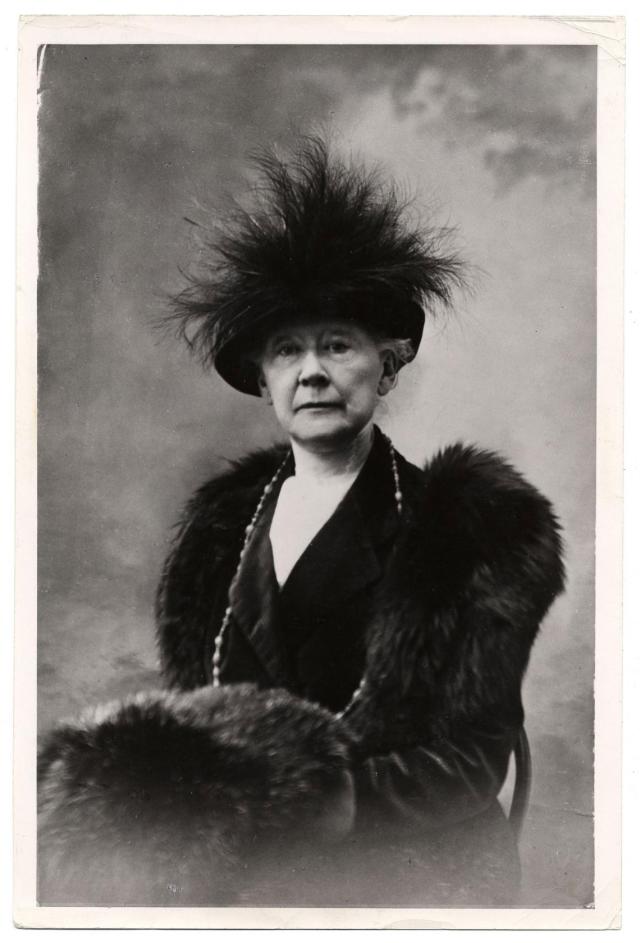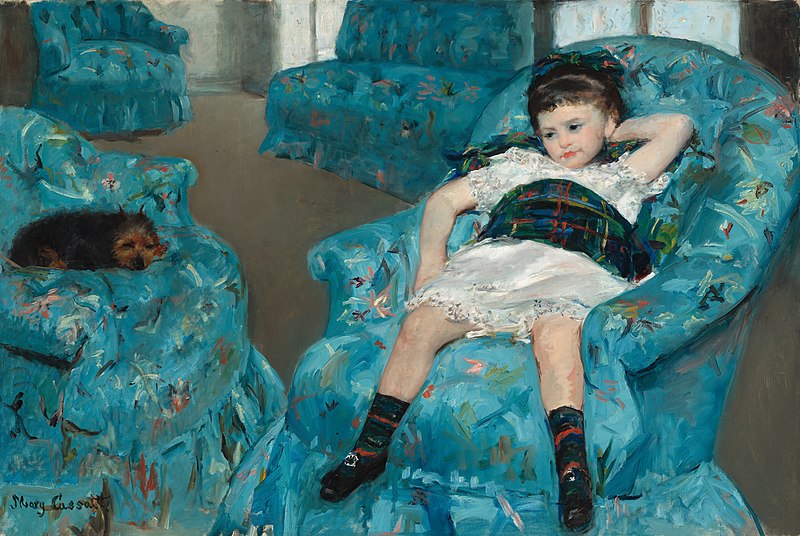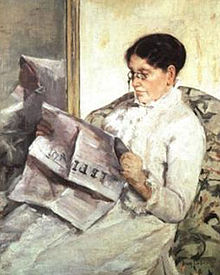Mary Cassatt, a modern approach to the painting of domestic life
Cet article a été rédigé dans le cadre d'un stage à l'ENS de Lyon.
Biographical introduction
|
[Photography of Mary Cassatt, after 1900. Source: TheArtStory, Public Domain]
|
Born in 1844 into a wealthy family of Pennsylvania, Mary Stevenson Cassatt began studying painting at the age of fifteen at the Academy of Fine Arts in Philadelphia, before moving to Paris in 1866 where she took private lessons from Jean-Léon Gérôme and copied masterpieces of the Louvre. From 1868 to 1874, her works were exhibited at the prestigious Paris Salon, but she then strayed from its academic artistic approach. Around the same time she discovered the work of Edgar Degas, which made a powerful impression on her: “It changed my life. I saw art then as I wanted to see it” she wrote to a friend ((In a 1915 letter to Louisine Elder, later Havemeyer, in Havemeyer, Sixteen to Sixty, 275.)). In 1877, he invited her to show her work with the group of the Impressionists and they became close friends – contrary to popular belief, she never was his pupil since she was already artistically trained when they met. She then developed a more personal style, deeply influenced by Degas who introduced her to pastels and printmaking. Like him, she was particularly interested in portraits and progressively specialized in depictions of mothers with their children to which she brought acute psychological insight. In addition to being an artist, Cassatt was also an advisor on art and as such was instrumental in shaping many private and public collections, and bringing French Impressionism to America. Thanks to her connections on both sides of the Atlantic, she notably encouraged her friend Louisine Elder to purchase French paintings (and eventually become the biggest collector of Degas), and helped Durand-Ruel, one of the great Parisian art dealers of the time, to open a branch in New York. By the end of her life her health and sight deteriorated until she became blind and had to stop painting. She died in France in 1926, after being awarded the Légion d’Honneur in 1904. |
1. A modern perspective on childhood and maternity
|
Cassatt excelled in figure compositions, and more particularly the portrayal of children and mothers which was very popular then. If the subject is a traditional one ((The depiction of children is a long-established topos of figure compositions, notably in aristocratic or family portraits, and in religious art through the figure of the infant Jesus.)), her works reveal a radically new perspective on childhood and maternity at a time when women’s social status underwent profound changes. In bourgeois circles notably, the role of mother was reassessed and increasingly perceived as rewarding, as opposed to that of nurses who were usually in charge of children until then. Furthermore, contemporary feminist discourses saw in childcare a liberating practice which gave mothers a role in raising and educating future generations. Cassatt never married nor had children herself, but she skillfully conveyed in her paintings the profound tenderness of the bond between mother and child, who are often depicted engaged in everyday activities or simply in a loving embrace. Her treatment of childhood scenes borrows from the tradition of religious representations of the Virgin and Child by Italian Renaissance artists like Donatello or Botticelli, especially in the intimacy conveyed by the gestures and glances. Stylistically speaking however, her technique is markedly influenced by Impressionism, in the use of a vibrant color palette and visible brushwork which make some of her works look barely sketched. |
[Mary Cassatt, The Child's Bath, 1893. Source: Wikipedia, Public Domain]
|
Most of all, it is in her unconventional vision of children that her modernity lies. The ambition to capture a signature moment so dear to the Impressionists is translated in her work into insightful evocations of tender instants of domestic scenes, and a clear desire to portray children as they are in real life, and not merely as an unnatural miniature version of adults as it has long been the case in artistic representations. Her subjects are often seen from unexpected angles, and do not appear to pose for the viewer but are rather focused on their own activity. In Little Girl in a Blue Armchair for instance, the child is slouched in an odd, almost languorous posture which gives the impression that the viewer is catching her unobserved as she takes advantage of her parents’ absence to indulge in a moment of slackness. As in this particular example, the children Cassatt portrayed often have an absent-minded look, which reflects the artist’s concern to reproduce this somehow melancholic poetry of childhood.
2. Asserting herself in a masculine world
|
[Mary Cassatt, Reading Le Figaro, 1878. Source: Wikipedia, Public Domain]
|
“I am not willing to admit that a woman can draw that well!” reportedly declared Degas when shown Mary Cassatt’s works. Such a remark is telling of the misogynistic prejudices circulating at the time which made it difficult for women to become professional artists - the École des Beaux-Arts was closed to them for instance. Mary Cassatt was one of the rare women to gain acceptance among eminent artists in Paris then, alongside painters like Berthe Morisot or Marie Braquemont. As Degas’s comment suggests, it was notably thanks to her exceptional talent and virtuosity that she was able to achieve recognition in a predominantly male sphere. Her work, though focusing largely on her favorite subject, displays an incredible variety of technical and stylistic experimentations as she produced oil paintings, pastels, drawings and prints. If her style is close to that of such impressionist painters as Édouard Manet or Claude Monet, she preferred to be considered as an “independent” artist slightly apart from the group. Indeed, her preference for portraits instead of landscapes or outdoor scenes distinguishes her from the group, as well as the maturation of her style towards a simpler, more straightforward approach under the combined influences of Japanese prints and Nabis painters such as Maurice Denis ((The Nabis were a group of post-impressionist French painters (among whom Paul Sérusier, Pierre Bonnard, Maurice Denis) active from 1888-1900 who sought to free form and colour from traditional descriptive functions. Their work is influenced by symbolism and is characterized by flat patches of colours, bold contours and simplified drawings. See for example Cassatt’s Young Woman in Green, Outdoors in the Sun (1914).)). |
Cassatt thus managed to assert herself and her talent, and her paintings reflect her overtly feminist beliefs and her role as an artist in renewing the image of women. On the occasion of the Chicago World’s Columbian Exposition in 1893, she painted a large fresco (now lost) ((The fresco has gone missing since the exhibition, and might have been destroyed while in storage due to the harsh criticism it attracted.)) for the Women’s Building entitled Modern Woman. Three panels illustrated allegorically “Young Women pursuing Glory”, “Young Women Plucking the Fruits of Knowledge and Science”, and “Young Women embodying Art, Music and Dance”, as a tribute to recent progresses in their education and independence. In 1915 she submitted eighteen works in an exhibition supporting women’s suffrage. This commitment can be seen in other works more generally, which represent women engaged in modern activities such as dancing, playing the banjo, or reading newspapers. Furthermore, her models rarely correspond to traditional standards of beauty, and reveal a deliberate choice to offer a different, non-eroticized vision of the female body.
3. Woman with a Sunflower: the blossoming of womanhood
|
[Mary Cassatt, Woman with a Sunflower, 1905. Source: TheArtStory (Public Domain)]
|
Mother and Child, also known as Woman with a Sunflower, illustrates Cassatt’s treatment of her theme of specialty at an advanced stage of her career. This painting depicts a woman sitting in a chair with her young child on her knees: both are looking at the child’s reflection in the small mirror they are holding while a larger wall mirror reflects the whole scene. The composition is structured by the colours, with the bright yellow of the mother’s dress and the reddish tone of her hair standing out from the monochrome brown background, and the green of the chair matching the frame of the wall mirror in a way which underlines the diffracted perspective of the reflection. The light colours of the dress and the padding of the chair mirror the models’ skin which reveals Cassatt’s attentiveness to the texture and various shades of whites, peaches, yellows and pinks composing it. Mirrors are a common device in in Cassatt’s works (for instance in The Oval Mirror, or Woman Bathing), and they create a complex dynamic of gazes and embedded images. Here mother and child are absorbed in the contemplation of the mirror on the left of the painting, but through the mirror effects the child seems to be looking directly at us. As for our own gaze, it is drawn to the hand-held mirror to grasp the complicity between mother and child, but also to the huge sunflower adorning the mother’s chest, and the reflection on the wall mirror. Yet the particular and slightly odd framing (typical of Cassatt’s works) which focuses closely on the figures to the point of cutting out part of the child’s feet places at the centre of the painting the mother’s hand laid on her child’s shoulder. The composition thus seems to invite us to consider the relationship mother-daughter as the real subject of the representation. |
Indeed, the mirror here is less a reference to the spectacle of women’s ornamental beauty (as in Woman with a Pearl Necklace in the Lodge for instance), but rather the medium of communication for the two beings, and a symbol of transmission from mother to daughter who are united in their looks and gestures in a circular pattern paralleled by the shape of the mirror. The innocence and nudity of the child is set up in contrast with the sophistication of her environment and of the fashionable dress of her mother. Yet the multiple echoing images created by the mirrors, and the motif of the blossoming sunflower (whose petals have a similar shape to the tip of the child’s hair) suggest the future transformation of the child into a grown-up woman like her mother, the painting thus becoming a representation of the transmission of feminine identity.
Notes
Bibliography
ANON. 2015. "Mary Cassatt Artist Overview and Analysis". The Art Story. https://www.theartstory.org/artist/cassatt-mary/.
ANON. “Biography of Mary Cassatt”. Mary Cassatt - The Complete Works. https://www.marycassatt.org/biography.html.
ANON. 2018. “Pierre Curie: Quand Mary Cassatt a découvert la peinture de Degas elle a compris que c’était l’avenir”. France Culture. https://www.franceculture.fr/emissions/le-reveil-culturel/pierre-curie-quand-mary-cassatt-a-decouvert-la-peinture-de-degas-elle-a-compris-que-cetait-lavenir.
BARNES, Julian. 2018. “Not in a Box”. London Review of Books 40, no. 8 (April): 8-9. https://www.lrb.co.uk/the-paper/v40/n08/julian-barnes/not-in-a-box.
BICHIER, Camille and PERRUCHE, Clément. 2019. “Morisot, Cassatt et Bracquemond : l'impressionnisme au féminin”. France Culture. https://www.franceculture.fr/peinture/morisot-cassatt-et-bracquemond-limpressionnisme-au-feminin
CRESSEVEUR, Jessica. 2015. “Temporality and Trauma: The Subversion of Normalization in Mary Cassatt’s Mother and Child (Mother Wearing a Sunflower on Her Dress)”. Southeastern College Art Conference. https://www.academia.edu/13079070/_Temporality_and_Trauma_The_Subversion_of_Normalization_in_Mary_Cassatt_s_Mother_and_Child_Mother_Wearing_a_Sunflower_on_Her_Dress_.
GRAFLY, Dorothy. 1927. “In Retrospect—Mary Cassatt”. The American Magazine of Art 18 (6): 305–312. JSTOR, www.jstor.org/stable/2393025.
POLLITT, Ben. “Cassatt: Little Girl in a Blue Armchair”. Khan Academy, https://www.khanacademy.org/humanities/becoming-modern/avant-garde-france/impressionism/a/cassatt-little-girl-in-a-blue-armchair.
SCHWABSKY, Barry. 2013. “Transient States: On Mary Cassatt”. The Nation. https://www.thenation.com/article/archive/transient-states-mary-cassatt/.
STADELMAN, Felicia Zavarella. 2014. “Through the Eyes of the Artist: Mary Cassatt”. Hudson Library Conference. Youtube video. https://www.youtube.com/watch?v=KWMQIMQm0K4.
YEH, Susan Fillin. 1976. “Mary Cassatt's Images of Women”. Art Journal 35 (4): 359–363. JSTOR. www.jstor.org/stable/776228.
Pour citer cette ressource :
Louise Bailly, Mary Cassatt, a modern approach to the painting of domestic life, La Clé des Langues [en ligne], Lyon, ENS de LYON/DGESCO (ISSN 2107-7029), septembre 2020. Consulté le 20/12/2025. URL: https://cle.ens-lyon.fr/anglais/arts/peinture/mary-cassatt-a-modern-approach-to-the-painting-of-domestic-life



 Activer le mode zen
Activer le mode zen




